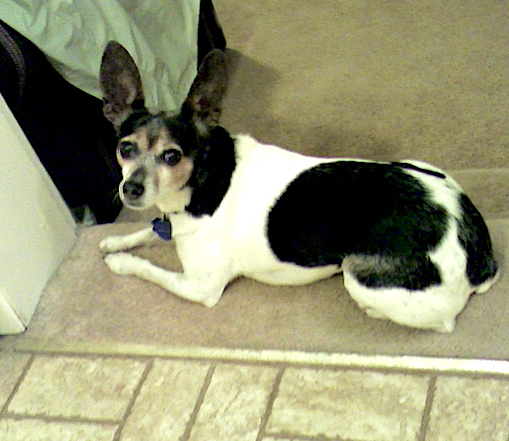Barks Blog
3 Reasons a Little Dog Might Not Lie Down on Cue
By Eileen Anderson
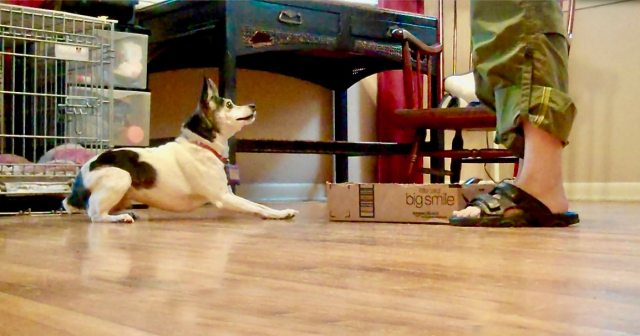
When I first started training dogs, things that didn’t work were a mystery to me. Why couldn’t I reward Summer with chasing squirrels like everybody said I could? Why couldn’t I find that slot in the layout of her teeth where the experienced trainers said she should hold the dumbbell? And why, oh why, could I not teach Cricket to lie down on cue? At first, I saw everything through the lens of disobedience: my dogs were wrong when things didn’t work out. As I learned more about training, I realized these things were on me. There was something I was doing wrong. But often, I still couldn’t figure out what it was.
When your primary source of dog training information is the internet, you are at a disadvantage. (Ironic, eh, for a dog blogger to say that!) What I mean is that even the way you identify and describe a problem can lead would-be helpful people down the wrong path. When you are new, you don’t have the information to assess the problem to begin with. So you can’t describe it well.
Back in 2007, when I was just starting to train, the situation was worse, because fewer people posted videos of their dogs. They were starting to, but YouTube was populated mostly with dog training videos by professionals. The idea that a newbie could post a video and get helpful critique from an expert was just getting off the ground.
That’s why I missed the two obvious reasons why Cricket didn’t want to lie down in training. Many more experienced people would have caught them.
Three Reasons a Dog Won’t Lie Down
Three reasons dogs (especially little ones) don’t want to lie down that have little to do with the mechanics of training are:
- Pain
- Discomfort with the surface
- Not feeling safe
So if you have a dog, young or old, who doesn’t want to lie down, first see a vet. #1 is the biggie. Seriously. Even young dogs can have painful joint conditions or other reasons why lying down is uncomfortable, especially in the “sphinx” position. And even when a pup will lie down, don’t overdo the “puppy pushups” thing. Let those little joints mature.
For Cricket it was Reasons #2 and #3
Luckily, Cricket didn’t have any pain associated with lying down. My vets and I never detected any. She regularly did a “sphinx down” at home. Here she is doing it.
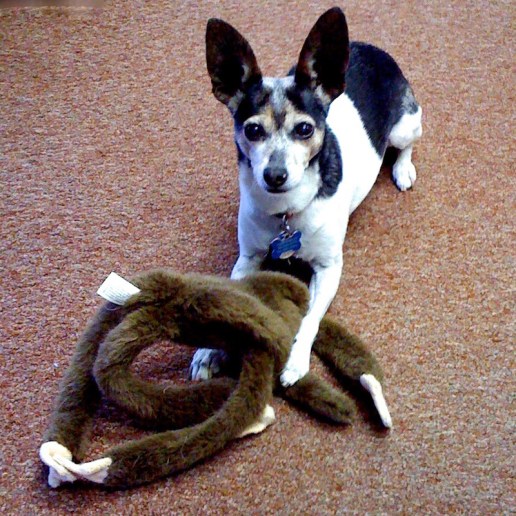
So what was the problem in the first photo above where her chest and belly are hovering an inch above the floor?
Two words: hardwood floor.
That floor was slippery, and I kept her nails longer than I would nowadays. If she had lain all the way down on it, she would have had to scrabble to get up. Plus, she likely didn’t care for the feeling of the cool, smooth floor on her little bare belly. This seems to be pretty common in small dogs with short hair. Cricket hovered even higher over the chilly concrete floor in my den.
In the two photos directly above where she is lying down naturally, she is on carpet.
No Lying Down at the Obedience Club
But then when I took her to the obedience club, they had nice mats with good traction. So why was she still keeping her chest off the floor? Apparently, this is so common with little dogs that they even had a name for it in the obedience world: “the bridge.”
Here she is performing a perfect bridge. Can you guess why?
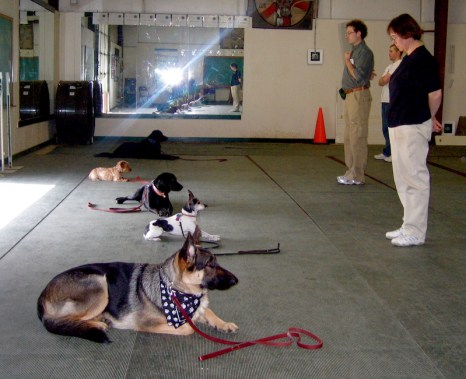
Here’s a closeup.
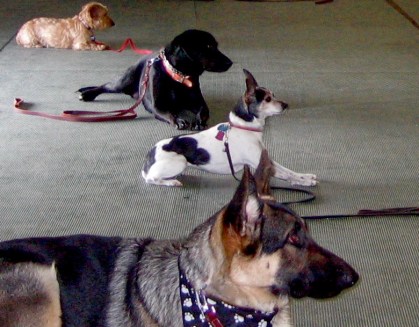
Cricket, as tough and willing as she was, was anxious. She didn’t feel safe enough to lie down in the club environment, surrounded by strangers and bigger dogs.
It saddens me now that I couldn’t see or respect her discomfort. If I did comprehend it somewhat, it just wasn’t important enough to me. I figured she’d get over her nervousness.
Look how brave she was! And look how much effort, how much muscle tension it took for her to maintain that bridge. She held it for a couple minutes at a time. I wish I had that core strength. She wasn’t going to lie all the way down, even though she was fond of the nice lab mix on her left. There were too many dogs, too much going on there, and she was little.
Another view of her at the dog club. It’s hard to detect body language in these old photos, but look at her ear set during this heeling exercise. Her ears were pulled back. Worried, and not a happy camper.
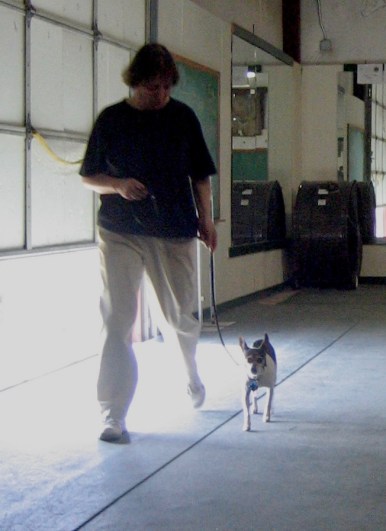
For contrast, here is Zani at the same obedience club. Zani is not without her stressors, but they don’t involve people, dogs, or new places. All those things are lovely, as far as she is concerned. Look how relaxed she is! It’s probably safe to say that Cricket never looked as relaxed as Zani in her whole life. Cricket was a worry wart, like me.
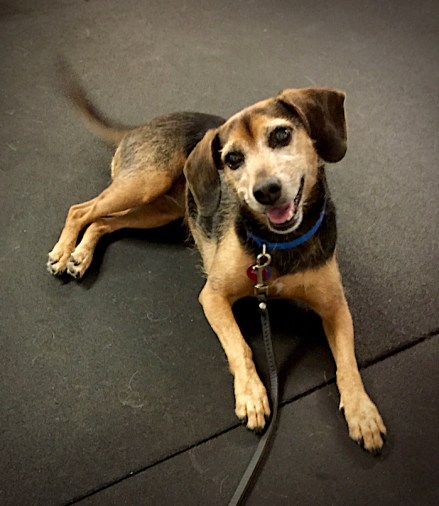
I said at the beginning that this kind of problem—a little dog who wouldn’t lie down in some situations even though I trained and trained on it—was on me. But it wasn’t precisely a training problem. It was a problem of observation and empathy.
I didn’t know enough to realize that more and more attempted reps weren’t necessarily going to make Cricket feel better about lying down. I’m not saying it couldn’t have been trained. It could have, with a more skilled trainer. But to do it well would have meant looking at the situation holistically and addressing Cricket’s anxiety first.
And that’s where the empathy comes in. I can be a little compulsive, a bit Type A about certain things. And by god, it drove me nuts that I couldn’t do something as “simple” as get my dog to lie down in an obedience class. So I had a little war with myself. One voice saying, “Why on earth is this important? It doesn’t matter! You aren’t going to compete with her! And she doesn’t want to lie down, so why stay fixated on it?” But the other voice was saying, “But she’s ‘supposed’ to.”
The first voice, the one that was both sensible and empathetic, did finally win out. I stopped forcing the issue. I gave up my idea of competing in rally obedience with her. (Yes, I really did consider it. It’s a tribute to what a brave and willing little dog she was, not indicative of any kind of good sense on my part.) I did keep taking her to the club, even as a stand-in for Summer once as a demo agility dog, and she did great. She got more comfortable at the club and made dog and human friends.
Reason #4 Why a Dog Might Not Lie Down on Cue
The title of this post, with the “three reasons” bit, is a little tongue in cheek. It’s a bit of clickbait. Of course there are more than three reasons, but I think I picked three important ones. There’s another one in Cricket’s case, though. I reinforced that bridge! I mean, wouldn’t you? The adorable, serious little dog was trying so hard and was so tense. Her belly was almost on the floor, and it never……quite…..got there. Yeah, I gave her treats for that. Way too many treats. Matching law hell. Bad training practice, but a good human, nonetheless. I’m not a bit sorry.
Copyright 2019 Eileen Anderson
About the Author
Passionate amateur dog trainer, writer, and learning theory geek. See more at https://eileenanddogs.com.

